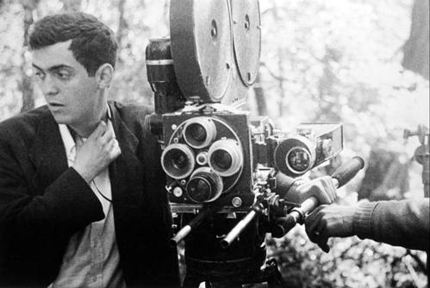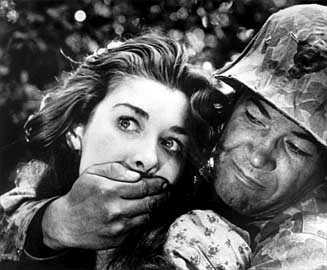
 |
|
|
|
Stanley Kubrick's Fear and Desire is one of those movies that we were told we'd never get a look at. I honestly think it had been forgotten until Andrew Sarris listed it in his book American Cinema. It received a very small release in 1953 and Kubrick pulled it shortly thereafter. As his career took an upswing later in the '50s Kubrick treated it as a beginner's mistake and wouldn't let it be shown. That only made the title more attractive to fans already fascinated by the short subjects Kubrick filmed during his careful segue from magazine photographer to film director. In the 1990s I read that The Eastman House had one print of the picture but would not screen it. They allowed viewings only by selected applicants, under controlled conditions, a setup that conjures visions of William Alland entering the forbidding research archives in search of clues about the life of Citizen Kane. Back in 1999 I was passed a bootleg VHS 1 containing a miserable, 20th generation copy of the movie in which one could barely make out the pictures, let alone the dialogue. It was such a find that I invited friends over. It resulted in an early Savant article, The Hidden Stanley Kubrick Feature. 
Although Kubrick seemed adamant that Fear and Desire be forever hidden, the roadblock barring its release has dissolved. A new copy made from 'archival 35mm' elements showed on TCM and has now hit both DVD and Blu-ray. Kubrick fans will discover the film to be a sober reflection on the meaning of war presented in self-described abstract terms. Other viewers may find themselves unsure of what they're looking at altogether. Kubrick made a career of turning grand calculated risks into innovative, sometimes revolutionary entertainment; in his first film he hasn't quite matched up his ambitions to his resources. Even geniuses have to start somewhere. The show begins like a hangdog episode of The Twilight Zone. A narrator tells us that the forest we see is at war, but not any particular war of the past or the future. The combatants do not exist unless we call them into being. Four very conventional, more or less American soldiers find themselves behind enemy lines. Lt. Corby (Kenneth Harp) has a plan to get to safety by riding a raft down a river. The pragmatic Sgt. Mac (Frank Silvera) has the most experience and takes the fore when the foursome charges an outpost shack, killing two enemy soldiers and stealing their food. The unbalanced Pvt. Sidney (future director Paul Mazursky) is put in charge of guarding a pretty local girl (Virginia Leith). Letting his libido get out of control, he slobbers all over her, unties her and watches like a fool as she escapes. The soldiers observe some high officers at another enemy outpost; Sgt. Mac helps sell the notion that they ought to use the opportunity to kill a general during their escape. But the attack doesn't go as smoothly as hoped... Why was Kubrick not proud of Fear and Desire? It's a serious meditation on a serious subject, and clearly the work of an artist. It has also been assembled with much care. The cinematography is beautiful and the acting reasonably good. Even the sound work is good. But it's also slowly paced and lacks a sense of humor. The title itself is pretentious, especially when the 'desire' part of the equation is Paul Mazursky's shaky one-act performance as a neurotic Sad Sack. The real content of the movie is standard low-end combat activity. 
The ambitious theme expressed in the narration isn't really developed in the film itself. Kubrick's main conceit is to have the enemy general and his aide played by the same actors as two of our lost patrol members, but nothing much is done with the idea. Frankly, I didn't realize that the casting was done this way until I read it somewhere. Character speeches tend to lapse into philosophical ruminations, as if influenced by the portentous narrator. Because Hollywood war movies both cheap and expensive often indulge in philosophical blather, hearing it here doesn't add to any ethereal mood. That comes only in occasional expressive visuals, as when Kubrick focuses on the face of a dead enemy, or a silhouetted survivor wading into a river, forming a portrait of a lost and abandoned eternal soldier. Interestingly, although his camerawork is impressive, Kubrick doesn't apply any overall stylization to his scenes, and saves most of his 'special' angles for the brief moments of violence, or shots with dead bodies, etc. The bulk of the movie shows the soldiers walking in a generic dry forested area (reportedly the San Gabriel Mountains outside Los Angeles) and arguing as a group. Just as in Hollywood productions, lost patrols in constant danger of detection stand in plain view and talk at a normal volume, without so much as looking over their shoulders. As with many ultra-low budget films, what might be key scenes are not depicted. The soldiers are there because of a plane crash, but we simply pick them up after the fact. The enemy headquarters seems understaffed, and an escape in an airplane is barely pictured. Not a lot of commercial action to be sure, even if Kubrick's final visuals do strike a pleasing poetic vibe. Fans will be interested to see Fear and Desire's solitary female actress, Virginia Leith. She played in a promising run of Hollywood movies but never got a breakout role. The impression I always got was that Leith was a spirited nonconformist shoehorned into typecast parts: Black Widow, Violent Saturday, A Kiss Before Dying,Toward the Unknown. I say spirited and nonconformist based on the cult status of her last starring feature, in which she gives a remarkable performance. Alas, in Fear and Desire Miss Leith spends most of her on-screen time with a gag in her mouth, reacting uncomprehendingly to Paul Mazursky's standup goofball act. The best performance in Fear and Desire is that of the dependable Frank Silvera. 
On his next film Kubrick would return to his stomping grounds of New York, for the minimalist but effective boxer vs. hoodlum noir Killer's Kiss. When he must pad scenes in that picture, the 'padding' consists of evocative street scenes, many taken on the sly, in the style of his superb still photography. It would seem that every new Kubrick film represents a giant step in the director's judgment and career savvy -- after Fear and Desire he internalized the lesson of "the story comes first". Kubrick never repeated himself and I can't say that he ever made the same mistake twice. Kino Classics Blu-ray of Fear and Desire is an extremely clean, beautifully transferred rendition of this handsomely filmed low-budgeter. Kubrick's camerawork looks good in the exteriors and very good in the few cramped interiors. Images of soldiers sitting around tables use the heavy "documentary style" top-light that works so well in Killer's Kiss, The Killing and even Dr. Strangelove. The one extra is The Seafarers, a Kubrick short subject from 1953. The color item was filmed for a sailor's union. It's not an artistic effort but a show to be screened at meetings to explain the union's hard-earned benefits. Seen today the picture is both nostalgic and sad. Do major ports still have union halls where sailors in transit can get hired, get meals, even sleep? Do sailors still have unions? I doubt that the various financial aid programs and family security concerns are addressed anymore, at least not at this level of organization. The print for The Seafarers is a grainy 16mm copy with some damage here and there, but in basically good shape. It's interesting to compare Stanley Kubrick with Roger Corman. Both entered the film business at the same time, as relative outsiders financing their own work. Each perceived that it was possible for outsiders to break in and each took a diverging path. Corman aimed for a marketable product, and Kubrick for a critical success that would attract industry attention. Both got serious traction on their efforts after only two years or so and were soon considered unique practitioners of their art. Kino's impressive cover art may be related to original poster or ad art, but I've never seen any. This Joseph Burstyn release didn't exactly blanket the nation coast to coast. Burstyn distributed mostly foreign acquisitions, like Miracle in Milan and Umberto D., and who knows if they made any money? Another domestic Burstyn release was the marvelous, well received Little Fugitive, a delightful story of a little boy lost at Coney Island. Not Kubrick's kind of picture, but you can bet that he saw it and envied its success.
On a scale of Excellent, Good, Fair, and Poor,
Fear and Desire Blu-ray rates:
Footnote:
1. VHS: An obscure tape-based video format of inferior quality, used long ago. Ask your parents.
Reviews on the Savant main site have additional credits information and are often updated and annotated with reader input and graphics. Also, don't forget the 2011 Savant Wish List. T'was Ever Thus.
Review Staff | About DVD Talk | Newsletter Subscribe | Join DVD Talk Forum |
| ||||||||||||||||||